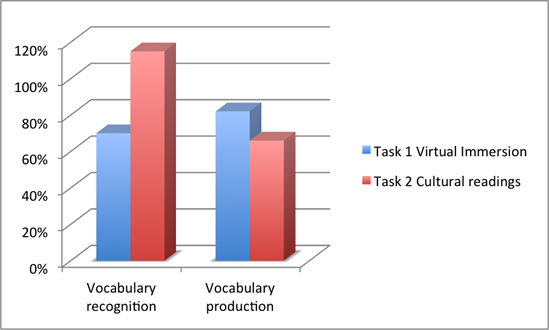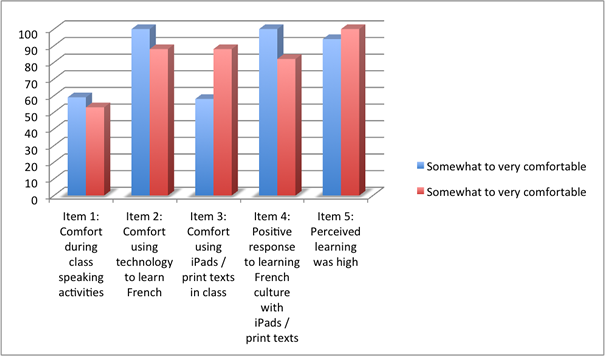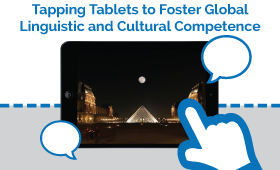Tapping Tablets to Foster Global Linguistic and Cultural Competence
 By Patricia Mosele, PhD, Lecturer of French at the University of Colorado Boulder.
By Patricia Mosele, PhD, Lecturer of French at the University of Colorado Boulder.
INTRODUCTION
Many language teachers recognize that beginning classroom learners struggle significantly when asked to apply strategies for interacting successfully with peers to actual authentic speaking situations. This may be the case because students’ exposure to authentic target culture information is very limited, which renders classroom language practice unnatural. In response, some argue that mobile technology enables students to access authentic target language documents that they can then exploit for real world oral communication purposes e.g., to carry out role play, information-gathering, and knowledge gap tasks. Additionally, while in-class pair activities engage learners in spoken communication, use of mobile devices allows them to interact in writing as well as in speaking, thus providing some with a preferred context for target language expression. Given the availability and relative low cost of tablet technology, I opted to design a plan to integrate iPad devices into communicative task-based activities in my hybrid beginning French classroom to see if these kinds of activities would motivate student inquisitiveness and shore up student learning.
In the present paper, I describe a model I have developed to create Virtual Immersion Experiences for beginning students of French at the University of Colorado Boulder and report results of an action research project I undertook to determine if students’ participation in virtual immersion truly resulted in linguistic gains.
WHAT IS A ‘VIRTUAL IMMERSION EXPERIENCE’ (VIE)?
The expression “virtual immersion” has been used in various ways. For my purposes, a Virtual immersion Experience, is a language learning activity that exploits authentic target culture web sites in a hybrid environment, i.e., one that offers some face-to-face peer interaction in the traditional classroom as well as asynchronous peer interaction online. Additionally, learners use authentic iPad applications to connect from their classroom in Boulder, Colorado directly to the target culture in Paris, France. These apps included ParisMétro, for navigating in and around the city, as well as Pariscope and Figaroscope for identifying cultural and entertainment venues and others, such as Ideat, Galléries Lafayette, and Paris en scènes, for learning about shopping, museums, restaurants and hotels.
The main objective of the “Visiter Paris” activity was to place beginning students of French in interdependent collaborative roles as they work together to plan a virtual class trip to Paris using target culture information accessed via iPad devices. This Virtual Immersion Experience took place over one week of classes during a regular 15-week semester at CU Boulder but, because it made use of online tools, completion only required two 50-minute face-to-face class meetings.
ACTION RESEARCH STUDY RESULTS
Research Questions
The reason I decided to undertake an action research study on the effectiveness of virtual immersion was that I wanted to be able to provide new information about how motivation and language learning in a hybrid setting are affected by use of electronic mobile technology as compared to traditional print materials. Thus, I proposed four research questions:
With respect to the problem of determining learners’ motivations for language-learning:
1. When participants perform traditional classroom reading tasks using print materials, how are their attitudes toward language learning affected?
2. When participants perform classroom collaborative communicative tasks using iPad technology, how are their attitudes toward language learning affected?
I chose to focus on just one linguistic aspect of language learning, vocabulary. With respect to the problem of determining participants’ success in learning target language vocabulary:
3. When participants engage in traditional classroom tasks using print materials, to what extent does the activity have an impact on vocabulary learning as evidenced by performance on periodic post-task assessments?
4. When participants engage in classroom collaborative communicative tasks using iPad devices, to what extent does the activity have an impact on their vocabulary learning as evidenced by performance on periodic post-task assessments?
METHODOLOGY
Participants
Participants in the study were 17 American university learners enrolled in a beginning French class. These participants ranged in age from 17 to 24 years. Of the 17 students, nine were in their first semester of college, five were in their second year, two were third-year students and one was in the fourth year. There were five males and 12 females. Sixteen of the students were native speakers of American English and one was a native speaker of Farsi. Seven students had previous instruction in French (from one to three years in high school) while the other ten students had never studied French before. The group, as composed, was generally representative of university classes of beginning French learners at the University of Colorado Boulder.
Data Collection
I used a number of instruments to get useful data, including: (1) pre-task assessments of learners’ existing knowledge of the French lexical forms they used in carrying out the two language learning tasks, (2) pre-task assessments of learners attitudes about language learning, (3) post-task and post-post task assessments of learners’ attitudes about language learning, administered one week apart, and (4) post-task and post-post-task assessments of learners’ knowledge of target language lexical forms, also administered one week apart. While data on learner attitudes were analyzed based on participant responses to survey questionnaires, data on vocabulary learning were collected using researcher-prepared instruments that included matching French words and expressions to their English equivalents (on the post-task assessment) and translation of the same French words and expressions into English (on the pre-task and post-post-task assessments).
Tasks
Task 1, A Virtual Immersion Experience
In Task 1, the technology-enhanced Virtual Immersion Experience, participants got involved in a collaborative communicative activity designed to facilitate planning of a virtual class trip to Paris for a long weekend. Participants were divided into three groups of four and one group of five. Each group took responsibility for one major component of the trip: lodging, food, daytime cultural activities, or evening entertainment. Then, each group was given an envelope containing instructions and play money (in “Euros”) that they could spend on their part of the trip. Each group of four was further divided into two pairs, with each pair responsible for a component part of their group’s overall task. For example, for the group responsible for cultural activities, one pair had to select monuments, museums, and historical sites to visit in the morning while the other had to select cultural venues for afternoons. Teams were seated together at round tables and each pair of partners shared one iPad device during the activity. These devices were pre-loaded with appropriate authentic French apps for accessing information participants would need to complete their tasks. Afterwards, students communicated their findings through group blog entries and then each individual student responded to the other groups’ posts. Finally, each group analyzed class members’ responses and reported those results.
Task 2, A Textbook-Based Reading
Task 2 was designed to get students to decode two cultural reading texts selected from the textbook currently used in the traditional beginning French courses at the same institution. The first of the two texts presented information on French sports and the second on French cinema. Both of these were topics that students had been working on in the hybrid course. Each text was handed out as sight-reading. Both texts featured English glosses for new French vocabulary; spot translation of other words and expressions was used to aid comprehension during in-class reading. Treatment of reading skill development followed a traditional teacher-centered approach that required participants to guess and predict meaning from context. After completing the sports text and the cinema text, participants performed follow-up exercises, (true/false and multiple choice activities respectively), to show that they had understood the readings. Collaboration occurred when participants’ performed those follow-up exercises together. Otherwise, communication was restricted to supplying English equivalents or French synonyms for the new French vocabulary encountered in each reading. Finally, outside of class, participants wrote short paragraphs describing their favorite movies and sports and compared their tastes to those of French people, as reported in the two reading texts.
RESULTS
On Learning French Vocabulary
Task 1, A ‘Virtual Immersion Experience’
In response to the question about changes in productive vocabulary resulting from the iPad activity, I found that all participants increased their knowledge of targeted French vocabulary as a result of participating in Task 1, the Virtual Immersion Activity. Even though that vocabulary was never explicitly taught to participants, the group as a whole increased its receptive lexical knowledge by 70% and its productive lexical knowledge by 82% with respect to pre-task performance.
| Vocabulary Recognition (Post-task) | Vocabulary Production (Post-post-task) | |
| Task 1: « Visiter Paris » | 70% increase | 82% increase |
| Task 2: Cultural print texts | 115% increase | 66% increase |
These findings are depicted in Figure 1 below:

Task 2, Textbook-Based Reading
In Task 2, participants engaged in a traditional reading exercise using two cultural texts selected from a college French textbook. As a result of taking part in the task and in its associated subtasks, participants experienced a 66% gain in productive lexical knowledge and a 115% increase in receptive lexical knowledge. These findings suggest that traditional reading tasks do indeed contribute significantly to receptive learning of vocabulary; however, the increase in productive lexical knowledge was significantly smaller for the traditional task as compared to the virtual immersion task.
On Attitudes Toward Language Learning
Task 1, A ‘Virtual Immersion Experience’
Participants responded to six questions concerning their attitudes toward participation in Task 1. Reposes were based on a 5-point Likert scale that was designed to measure their affective reactions to completing Task 1, a Virtual Immersion task based on purposeful reading using authentic iPad apps. Questions focused on participants’ comfort levels during general class speaking activities, their feelings about using technology generally to learn French, their perceptions of the ease or difficulty involved in talking with classmates to carry out iPad-based activities, their reactions to using iPad devices to access French culture, and their perceptions of how much they learned using the iPads in the virtual immersion experience.
| Task 1: Visiter Paris | Task 2: Reading two cultural texts | |
| Somewhat to very comfortable | Somewhat to very comfortable | |
| Item 1: Comfort during general class speaking activities | 59% | 53% |
| Item 2: Comfort using technology to learn French | 100% | 88% |
| Item 3: Comfort using iPads/print texts | 59% | 88% |
| Item 4: Positive response to learning French culture via iPads/print texts | 100% | 82% |
| Item 5: Perceived learning was high | 94% | 100% |
These findings are depicted in Figure 2 below:

Task 2, Textbook-Based Reading
Only 59% of respondents reported feeling somewhat to very comfortable performing general conversational activities while 53% said that they felt somewhat to very comfortable participating in conversational activities related to the iPad-based task. While 100% responded that they felt somewhat to very comfortable using technology to learn French, only 59% said that they found it somewhat to very easy to use iPads while learning French. All participants (100%) reported that they reacted somewhat to very positively to learning about French culture using iPad devices and 94% responded that they perceived that they learned a fair amount to a large amount by using iPads in class activities.
Study participants responded to six questions about their attitudes toward language learning in general and to reading traditional texts more specifically. Those responses were also based on a 5-point Likert scale designed to measure affective reactions to completing Task 2, a traditional textbook-based reading activity. Questions focused on respondents’ attitudes toward participation in classroom speaking activities generally, toward participation in speaking activities specifically related to the teacher-led text-based readings from Task 2, participants’ perceptions of the difficulty involved in sight-reading in class, and their perceptions about how much they learned by participating in such activities.
Results showed that 53% felt somewhat comfortable or very comfortable participating in class speaking activities, 88% responded that they felt somewhat comfortable to very comfortable discussing text-based cultural texts with classmates, 82% reported that they found it somewhat easy to very easy to read French texts in class, and 100% responded that they perceived that they learned a fair amount to a large amount from the reading treatment in class.
INTERPRETATION OF RESULTS
Vocabulary Learning
Learners engaged in the Visiter Paris activity increased their knowledge of vocabulary at a rate 16% higher than that observed as a result of a traditional reading activity. And, what’s more, as part of the virtual immersion experience, participants also interacted with the target culture, built community through collaboration and cooperation, and communicated with their peers and instructor in a supportive learning community. As a result, they become active learners who took responsibility for their own learning. Video recordings of participants involved in each task clearly showed high engagement during Task 1 as compared to passive participation during Task 2. A conclusion that can be drawn from these results is that there is a positive effect on vocabulary learning as a result of learner participation in engaging, task-based communicative activities supported by technology. Consequently, I recommend using such activities in the classroom.
Attitudes
Survey findings clearly indicated that participants held equally positive attitudes toward both the virtual immersion experience embedded in the Visiter Paris task and the traditional reading task. On the one hand, these results point to a generally motivated group of learners. On the other hand, one may equally conclude that since learners’ attitudes toward use of mobile technology in the classroom remained positive, there is no reason for instructors to be wary of introducing them for classroom use. Therefore, I encourage language instructors to investigate how to best exploit mobile technologies in pursuit of language learning objectives.
Implicit versus Explicit Learning
It is important to note that there was no explicit teaching of the new vocabulary introduced as part of the Visiter Paris task. Learners referred to a list of task-related French expressions along with their English translations while executing the Visiter Paris activity. Task-related vocabulary was learned incidentally, i.e. implicitly. Further evidence of the incidental nature of vocabulary learning in Task 1 was seen in the debriefing session when participants’ comments’ indicated that they were unaware of having learned vocabulary as a result of participating in Task 1. Given that result, I recommend making students aware that they will learn new vocabulary while participating in a virtual immersion experience.
Active Learning
Since new vocabulary from the traditional textbook-generated reading task was taught explicitly, it is not surprising that participants showed a greater increase in recognition ability post task. However, participants gained vocabulary knowledge at the productive level at a much lower rate in the traditional reading task as compared to the virtual immersion task. One may conclude from these findings that the factor that most influenced gains in vocabulary knowledge was use of the target language in authentic cooperative, collaborative communicative activities. The key word in the preceding sentence is “use,” I suggest that instructors set objectives for communicative use of the target language for each lesson.
IMPLICATIONS OF THE ACTION RESEARCH STUDY
On a practical level, what the present study reveals is that technology represents both a rich medium and an efficient vehicle for language learning by facilitating learners’ access to the target culture to carry out naturalized real world activities. Furthermore, findings from the study clearly indicate that there is significant justification for adopting innovative technology-supported activities that promote collaboration, cooperation and communication in classroom language learning.
CONCLUDING REMARKS
What the virtual immersion experience shows us is that face-to-face class time can be used effectively to motivate learners to engage, read, discuss, share ideas, and cooperate in simulated real world activities that make use of authentic cultural materials and connect the classroom to the target culture using technology. Students become active learners as they seek out information from target cultures that interests them and as they cooperate with each other to communicate. This kind of experience is certainly appropriate for encouraging our students to become responsive members of global society.

